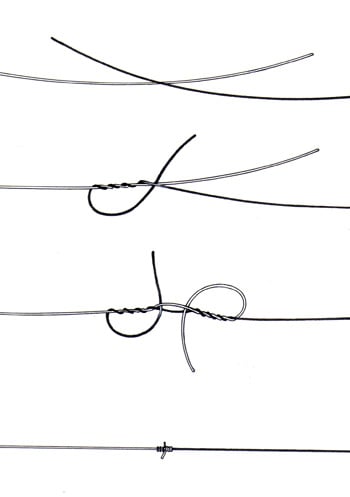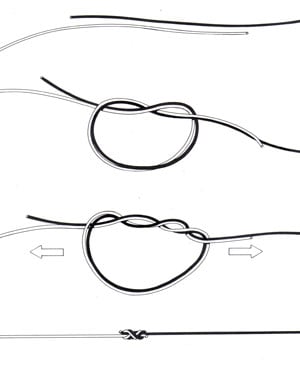Which Knot: Blood Knot or Surgeon’s?
Have a question you want answered? Email it to us at [email protected].
Question: Blood knot or surgeon’s knot, and why?
Evan P., Berkeley, CA
Answer: I am a blood-knot guy. It’s the one I learned first, and I’ve tied it enough that I can tie a blood knot well every time (pretty quickly, I might add). Plus, it’s a beautiful knot—elegant and symmetrical.
But why take my word for it? I threw the question out to the usual suspects, and here’s what they had to say:

The Blood Knot is one of the first “complicated” connections that most fly fishers learn, but it becomes easy to tie with practice and makes a slimmer connection. Illustration by Jonathan Milo.
Brant Oswald, guide and fly-fishing instructor: I am a blood knot guy, too, for similar reasons.
My issue with a double surgeon’s is that—even when formed correctly—the knot does not always draw up correctly for maximum strength. If one strand cuts across the other as the knot rolls over into the figure 8 as it is tightened, the knot will be quite weak, and it is not due to any error on the part of the angler tying the knot. My mantra when I teach a surgeon’s knot to beginners is to test, test, test the knot before it is fished. This is true for any knot, but absolutely critical with a surgeon’s.
I hardly ever use a surgeon’s knot in my own fishing. It does have advantage of allowing two sections of material of relatively dissimilar diameters to be joined together, but this is usually only important in an emergency situation, say to cobble together a usable leader in the last couple of minutes of light.
The surgeon’s knot is much bulkier, which is usually not an issue if it is only used only with smaller sizes of tippet material. However, if an angler is building hand-tied leaders or making connections in the heavier part of the leader (e.g., butt section to the butt of a new leader), then the blood knot’s slimmer profile is a distinct advantage. And the right angle tag ends of a blood knot offer opportunities in rigging: tandem flies with one on the point and one on the blood knot dropper, a nymph on the point with extra weight attached to the dropper, etc.
And, like Phil, I admit that a big part of my attachment to the blood knot is aesthetic. I watch thousands of them come together in my hands every season, and there is still something very satisfying about drawing up a well-tied blood knot.
Tom Rosenbauer, author of the Orvis Fly-Fishing Guide: I use a blood knot if the diameters are within .001 inches. I tie a triple surgeon’s if they are not, or if I’m going from Fluoro to mono. Why? Because I trust the triple surgeon’s more when materials differ.
Lori-Ann Murphy, co-founder of Reel Women, and fishing and guest relations host of El Pescador Lodge: I recognize that the surgeon’s knot is stronger—especially when it involves attaching materials that differ more than the 2-size grace rule we use with blood knots—but I’m a blood-knot gal ‘cuz it is so beautiful and streamlined.

The Double Surgeon’s Knot is easier for many anglers to tie — especially in low light or adverse conditions. Illustration by Jonathan Milo.
Ted Leeson, author: Blood knot for me, partly because I tie my own leaders, and surgeon’s knots are unsuitable for the purpose, and partly I like its symmetry. I think blood knots get a bad rap for two reasons: first, people think they are hard to tie, but that’s just a matter of practice. And secondly, they think blood knots are weaker. I’ve actually talked to a number of line manufacturers and independent testers about the relative strength of the two knots. Many people insist that the surgeon’s knot is stronger, which may be the case. But I spoke with a person at DuPont (which makes various brands of monofilament) who told me that, in tests, the relative strength of the two knots varies a good bit with the person tying them. Under “ideal” circumstances, if such things exist, a surgeon’s knot may be intrinsically stronger, but for any given angler, it might not be. In the end, go with what you tie best, unless you’re building leaders, in which case there’s no substitute for a blood knot, at least in the butt and midsections.
Dave Kumlien, guide and executive director of the Whirling Disease Foundation: I used to tie the blood knot but switched to the surgeon’s about 30 years ago. The surgeon’s is easier to tie, a bit stronger, and can be tied large under poor light with cold hands and pulled “small.” The blood knot doesn’t offer this option. Plus, I’ve taught fly fishing and fly casting for over 35 years, and I teach the surgeon’s both as a tippet knot and a tie-on-the-fly knot to beginning fly fishers.
I was shown the surgeon’s loop as a tie-on-the-fly knot many years ago by Al Troth, and it works great. I use it myself, all the time. By using the surgeon’s for a tippet and a fly knot, I am able to teach the beginning fly fisher one knot, the surgeon’s, which covers all their on-the-water-knot needs. The drawback to the surgeon’s is that it uses up more tippet material, and it clearly is not as elegant as the blood knot.
Ben Romans, angling writer: Well, I have a confession to make: I use an improved clinch knot to splice tippet. I know, I know, that probably goes against fly-fishing 101 protocol, but I’ve gotten so good at tying that knot over the years that I use it whenever I’m in a rush. Don’t ask me how I do it because I’ve showed dozens of people and most don’t have the finger dexterity to do it.
That said, my opinion is probably moot—but I’ll give it to you anyway. When I don’t tie the clinch, I tie the blood. It’s very similar to the clinch, so I can form the needed wraps in a jiffy, and in my little world, I remain convinced it’s stronger than a surgeon’s knot. I also feel like I waste less material (long tag ends) tying a clinch or blood versus a surgeon’s.
Joe Healy, editor of Fly Rod & Reel: Surgeon’s because it’s never failed me and is a bit easier to tie than the blood, particularly with cold hands.
Matt Supinski, Great Lakes guide: The blood knot is good, pretty, and goes through the guides of the rod smoother than a surgeon’s. BUT, only if similar diameters of leader are used. If you’re attaching two quite different diameters, the blood knot may fail.
The surgeon’s is very strong on all differing sizes of leader—a triple surgeon’s is better than a double—but you MUST lubricate the knot with saliva and slowly draw the loops together for a smoother, more blood-knot-looking surgeon’s knot.
Steve Hemkens, head of fly-fishing product development for Orvis: I like the blood knot for its symmetry and for tying materials of dissimilar diameters. I also like it for building out a leader that gets too short where I need to add a few sections because it’s straight, whereas a surgeon’s has a bit of a kink. I like the improved blood a lot for tying together two dissimilar materials together, even though it’s not a 100% knot like the slim beauty.
I find that a blood is easier for a beginner to tie, provided they use their thumbnail, if they have one, to help isolate both tags and pull them through. I have heard through the grapevine that a triple surgeon’s is a stronger knot, so I usually use that when I’m being lazy, but I am a blood knot man.











